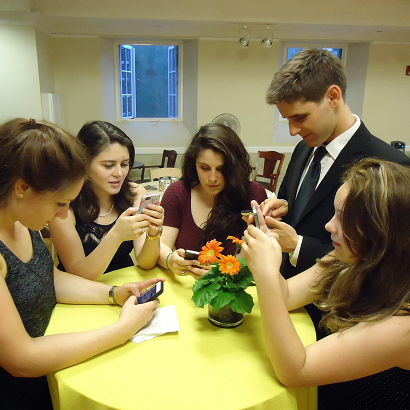Gen C is the dominant power on the Internet. They decide what gets shared. They decide, collectively as tribes, whether something is good or bad—and influence the opinions of everyone else with the power of their united voice. They can cripple a business, individual, or organization, or skyrocket it to success.
So, how can you get them on your side? How can you get them to promote your business rather than tear it down?
This article is the second of a two-part series—if you’re new to the topic, start by reading about the defining traits of Generation C.
1. Focus on Tribes
Bono greets the pre–Gen C tribe he built: his fans.
Marketing to the Gen C individual is extremely complicated thanks to their tribal chameleon behavior. Their interests are so unique and near-contradictory that they’ll just send your head spinning. How does one market to a survivalist Belieber, or an activist gamer?
You might occasionally find a deep niche by exploring the different tribes each member of your audience belongs to, but for the most part, it’s not going to be worth it. You’re better off marketing to activists or to gamers than trying to make a video game that appeals to activists.
Focus on the tribes. You don’t have to win over every member of Generation C; if you win over one of their tribes, they will approve of you by default.
Learn about the tribes that are most interested in what you have to offer. Discover their dominant opinions. What do they love? What do they hate? What pain points do they always bring up? To whom and what are they loyal, and why?
If you can address these issues in your content rather than just talking about yourself, you will be much more likely to get Gen C’s attention—and win over tribes that will vouch for you.
2. Deliver Authenticity—Quickly

"I can totally teach you how to swim."
As we mentioned before, quality control is out the window. Each member of Generation C now works as both consumer and gatekeeper. When they look for an article to read, they use Google as their slush reader to filter out the worst, critically glance over a few of the top results, and then read the one that most impresses them. They have a keen eye for good content and no patience for garbage.
Yet, it’s not necessarily about polish. As one Gen C interviewee says in the YouTube ad below, “I don’t care if it’s shot with a professional camera. I want the information.”
These are people who are used to seeing some rough edges on productions because they’re used to stuff created by their peers. A portion of them will accept websites that don’t look or read like they were created by professionals. What they won’t put up with are slow sites, bad navigation, disruptive advertising, and inauthenticity. They want instant gratification, and they seek honesty and integrity.
In short, many of them would rather learn to improve their basketball game by watching YouTube videos made by a high schooler who plays every day than from a fancy corporate website made by people who couldn’t sink a foul shot.
What matters most is that the information is authentic and has heart. Start with those building blocks, and then add on the fancy graphics and technical wizardry later.
3. Keep It Entertaining
Once again, instant gratification is critical to Generation C. They don’t just want to learn something—they want to be entertained while they are learning. Every part of the process should be enjoyable.
Try to impress your audience. Try to inspire them. Make them laugh or cry. Give them something interactive, or have them try things along the way. Don’t just deliver information—make the entire process of learning that information connect with them on an emotional or physical level.
Odds are, the Gen C members of your audience are consuming one or two other forms of content while they are consuming yours. Quite possibly they’re participating in multiple social media conversations and watching Netflix while reading your article. If you want their full attention, you have to earn it.
4. Be As Connected As They Are
It deserves restating: while consuming multiple forms of content, a typical member of Generation C is also communicating with others. It might be on social media, or it might be by email, text message, or all of the above and more. They are near-cyborgs in constant communication with the collective.
When they get in contact with one of their friends, they expect an instant response because they deliver instant responses themselves. And when they contact a company, they expect it doubly so, because somebody’s being paid to answer them.
This is where Generation C is frustrated again and again.
Let’s say one of them has a problem with a product she purchased. Since she’s already on Facebook, she tries to contact the company there. No response—for a whole day.
She tries email next. She’s thrilled to see an email in her inbox a minute later—then disappointed to find that it’s nothing more than a canned response directing her to the company’s FAQ page, which completely fails to answer her question. There appears to be no way to reach a human by email.

Hell hath no fury like a member of Gen C dealing with bad service.
Frustrated, she calls the company’s customer support number. She spends five minutes wading through a phone tree before getting the option to talk to a live representative. She’s then put on hold.
As she waits, she begins updating her social media channels with the story of her trials and tribulations. After another five minutes of listening to muzak, she hangs up in frustration and starts posting negative reviews.
Her tribe immediately shares her negative posts. Before long, the company that made the faulty product is on their blacklist.
The power of this kind of connected consumer is more tangible than that of any previous generation. They understand that companies are reliant on them and won’t hesitate to apply pressure to get what they want. And what they want is companies that don’t waste their time.
Generation C isn’t just impatient; they are time-poor and can’t afford to jump through hoops or wait around for answers. They want, expect, and need companies to be exactly where they are online, and to give them the same sort of rapid answers they can usually get by searching on Google. You therefore must provide multichannel support and fast, accurate responses.
If your company is selling to Generation C online, I strongly recommend you read our guide to providing and improving ecommerce customer service. It covers the tactics and technologies best suited to providing the kind of customer service you need to keep this generation on your side.
Summary
Generation C is not just another name for the Millennials; it is the name for anyone who has turned the Internet into an extension of themselves, and for whom being disconnected is like losing an arm. They are the people who decide what succeeds and what fails online. Your brand’s online success depends on winning them over.
To do that, you must give them exceptional content and customer service with equally exceptional speed. You must be honest and real and act with some sense of responsibility to the wider world around you. And finally, you must take the time to understand their tribes so you can win them over.
If you want to learn more about specific strategies that resonate with Generation C, I recommend reading the following:
- Amazon CRM Strategy: 4 Lessons for Ecommerce Sites
- eBay CRM Strategy: Know Thy Customer
- Ecommerce Customer Service from Startup to Success
- The Definition of Exceptional Customer Service
- Benefits of Relationship Marketing (and Its Disadvantages)
- Customer Service Strategy: 5 Key Elements of Success
The better you understand Gen C, the better your odds of success. It is impossible to overestimate their value.







